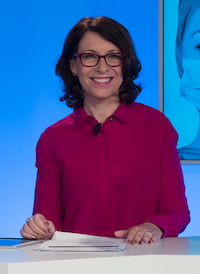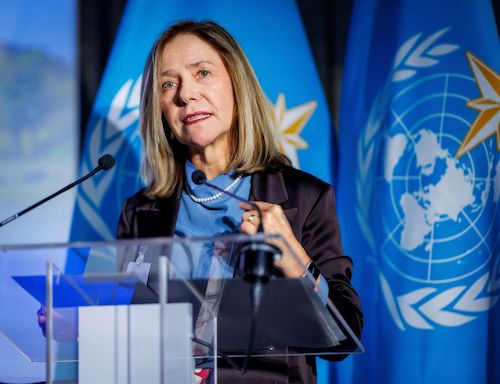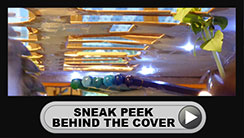From the time humans gathered around fire, our minds have been drawn to stories. It’s instinct — the way our brains lean forward when a tale begins, eager to connect, to feel, and to imagine what comes next. Stories don’t just entertain us. They move us and inspire us.
I am always struck by it – rooms filled with overcomplicated PowerPoint slides and speakers piling on facts like bricks, rather than telling a good story whose emotional pull, if well told, we will always remember.
Below are three examples of good storytelling during an event that I hope will inspire you to tell more stories.
1) Stories on panels: At Geneva Peace Week, I helped the Women’s International League for Peace and Freedom design a panel where the speakers were asked to share their stories with the audience. The team created a space for the audience to think differently and listen deeply. People were shown to their seats by torchlight. They listened in darkness to an audio recording we created to mark an event in history, and then the moderator went on stage.
She turned on the light next to her and asked each speaker one by one to turn on their side light and tell a 3-minute story before she moderated a discussion. It was a
STAR panel (something they will always remember).
2) Stories for the concluding panel: As a moderator, I know it can be challenging to keep the attention of the audience right to the end. A woman whom I have been training to moderate used storytelling to great effect at a recent international environmental conference. She told a story in her introduction, and then asked the audience to turn to their neighbour and to tell a story about something that had given them hope during the event. She then asked the panellists to do the same.
The story she told was made famous by the environmental activist, Wangari Maathai – Kenyan environmental activist and the first African woman to receive the Nobel Peace Prize. Wangari told the story of the hummingbird, which, in the face of a raging forest fire, did not despair but took action by carrying drops of water in its beak to put out the fire. She believed that everyone could make a difference, no matter how small their actions seemed. You can watch it
here.
3) Stories in closing remarks: Wrapping up an event can be tricky — trying to distil hours of discussion into a few meaningful closing remarks. At an event I moderated last week, the Secretary General of the World Meteorological Organization, Celeste Saulo, chose a different path. Instead of listing key points, she told a story — one that conveyed why the world needs the WMO and resonated far more deeply with the investors in the room.
She told the story of Melissa, the category 5 tropical storm that hit Jamaica. “Melissa will break many records”, she said, “But the loss of life will be minimized thanks to international collaboration built on shared data and trusted systems.” You can see the full speech
here – a great example of how to use stories to inspire and motivate.
Author's bio
 Claire Doole is a former BBC correspondent and international spokeswoman who is passionate about helping people communicate with confidence. Since 2006, she has successfully trained hundreds of professionals in the art of presenting and public speaking, talking to the media, managing communications in a crisis, and writing for the web. In addition, she has coached C-level executives and public figures to give powerful TEDx and TED style talks in Europe and the Middle East. A Swiss and UK national, Claire trains and coaches in French and English.
Claire Doole is a former BBC correspondent and international spokeswoman who is passionate about helping people communicate with confidence. Since 2006, she has successfully trained hundreds of professionals in the art of presenting and public speaking, talking to the media, managing communications in a crisis, and writing for the web. In addition, she has coached C-level executives and public figures to give powerful TEDx and TED style talks in Europe and the Middle East. A Swiss and UK national, Claire trains and coaches in French and English.
Claire is also a highly experienced moderator having facilitated panel discussions with government ministers, NGO activists, humanitarians and human rights specialists at major events.
Claire helps clients design their virtual, hybrid and in-person events and runs workshops on organising and moderating at events.
www.doolecommunications.com

 Claire Doole is a former BBC correspondent and international spokeswoman who is passionate about helping people communicate with confidence. Since 2006, she has successfully trained hundreds of professionals in the art of presenting and public speaking, talking to the media, managing communications in a crisis, and writing for the web. In addition, she has coached C-level executives and public figures to give powerful TEDx and TED style talks in Europe and the Middle East. A Swiss and UK national, Claire trains and coaches in French and English.
Claire Doole is a former BBC correspondent and international spokeswoman who is passionate about helping people communicate with confidence. Since 2006, she has successfully trained hundreds of professionals in the art of presenting and public speaking, talking to the media, managing communications in a crisis, and writing for the web. In addition, she has coached C-level executives and public figures to give powerful TEDx and TED style talks in Europe and the Middle East. A Swiss and UK national, Claire trains and coaches in French and English.








